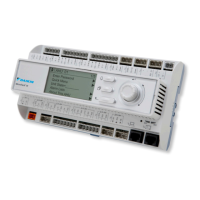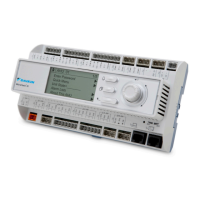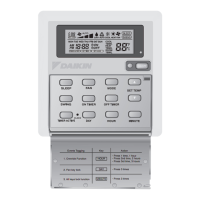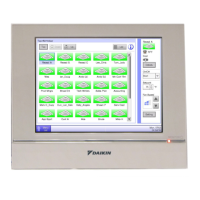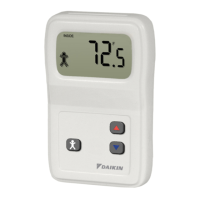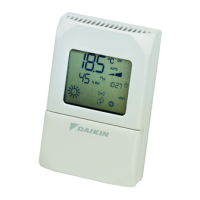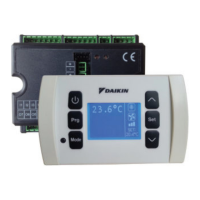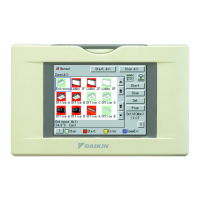What does 'Fin Temperature Sensor Alarm' mean on my Daikin MicroTech III DPS Controller?
- BBenjamin CastilloSep 10, 2025
If your Daikin Controller displays 'P4: Fin Temperature Sensor Alarm', it indicates an alarm from the fin temperature sensor.
What does 'Fin Temperature Sensor Alarm' mean on my Daikin MicroTech III DPS Controller?
If your Daikin Controller displays 'P4: Fin Temperature Sensor Alarm', it indicates an alarm from the fin temperature sensor.
What does 'Electrical Thermal (Surge)' mean on my Daikin MicroTech III DPS?
If your Daikin Controller displays 'L8: Electrical Thermal (Surge)', it indicates an electrical thermal surge.
What does 'Momentary Over Current' mean on my Daikin MicroTech III DPS?
If your Daikin Controller displays 'L1: Momentary Over Current', it indicates a momentary over current issue.
What does 'Power Supply Imbalance' mean on my Daikin MicroTech III DPS?
If your Daikin Controller displays 'P1: Power Supply Imbalance', it indicates a power supply imbalance.
What does 'Electrical Thermal (Out of Step)' mean on my Daikin MicroTech III DPS?
If your Daikin Controller displays 'L8: Electrical Thermal (Out of Step)', it indicates an electrical thermal issue (out of step).
What does 'Power Supply Insufficient' mean on my Daikin MicroTech III DPS?
If your Daikin Controller displays 'U2: Power Supply Insufficient', it means the power supply is insufficient.
What does 'Model Setup Problem' mean on my Daikin MicroTech III DPS?
If your Daikin Controller displays 'PJ: Model Setup Problem', it indicates a problem with the model setup.
What does 'Current Sensor Alarm' mean on my Daikin MicroTech III DPS Controller?
If your Daikin Controller displays 'L1: Current Sensor Alarm', it indicates a current sensor alarm.
What does 'Startup Prevention (Startup)' mean on my Daikin MicroTech III DPS?
If your Daikin Controller displays 'L9: Startup Prevention (Startup)', it indicates a startup prevention issue during startup.
What does 'Electrical Thermal (Current 2)' mean on my Daikin MicroTech III DPS?
If your Daikin Controller displays 'L8: Electrical Thermal (Current 2)', it indicates an electrical thermal issue with current 2.
Introduces the MicroTech III controller for refrigeration-only controls.
Provides general information about the MicroTech III control system.
Explains the "velocity" form of PI loop and adjustment parameters.
Guides field technicians on unit setup with key topics.
Highlights hazards like temperature, moisture, and static discharge.
Explains the IFB board's role in translating communication protocols.
Describes the physical controls and navigation methods of the keypad/display.
Outlines the organization of menus and items accessible via the keypad/display.
Details access levels and password entry for menu functions.
Explains how to navigate pages and edit values using the keypad and wheel.
Details overriding timers for testing and operational sequences.
Entry points for basic operations, status, and set points.
Menus for viewing/setting unit parameters and advanced configuration.
For manual operation, diagnostics, and system settings.
For setting up unit specifics and viewing alarm information.
Summarizes unit status and control items.
Displays temperature readings and fan flow status.
Configures basic unit settings, timers, and fan parameters.
Configures compressor, expansion valves, defrost, and alarm/event settings.
Manages configurations, tracks hours, and displays active alarms/logs.
Shows status of I/O points, Modbus, and network settings.
Configures alarm/event logging and IP network settings.
Configures HMI display and calibrates temperature sensors.
Configures onboard trending for data points and export options.
Brief descriptions of items available in the Quick Menu.
Summarizes unit status and control items with parameters.
Explains each item within the Unit Status Settings menu.
Displays unit temperature status information from various sensors.
Indicates fan status and controls supply/exhaust fan speeds.
Sets current time, date, UTC difference, and daylight savings.
Configures basic unit settings, name, and timer parameters.
Configures supply air fan settings like speed and RPM.
Configures return/exhaust fan settings like speed and RPM.
Displays and configures inverter compressor operational states and parameters.
Shows fault codes and refrigerant circuit pressures/temperatures.
Explains compressor operating states and their implications.
Details PI loop parameters and lockout settings for compressor control.
Displays and configures outdoor fan status and PI loop parameters.
Shows refrigerant status and specific OA fan PI loop settings.
Displays valve status and refrigerant pressures/temperatures.
Configures settings for EVI and EVO valves, including superheat and subcooling.
Shows the state diagram for defrost operation transitions.
Describes conditions triggering defrost and its temperature/time methods.
Sets alarm delay times and logging options.
Configures event logging and snapshot capture settings.
Lists adjustable parameters for manual control of unit components.
Saves/restores user configurations and resets to factory defaults.
Tracks operational hours for various unit components.
Displays active alarms and logs recent alarm events.
Provides diagnostic info on unit analog inputs and sensor readings.
Shows diagnostic info on universal inputs/outputs.
Displays current status of controller's digital inputs and outputs.
Shows Modbus status and allows sensor calibration.
Lists configuration variables defining unit type, cooling, heating, etc.
Configures onboard trending for data points and export options.
Lists default trending points available for ROC units.
Displays unit identification and configuration string details.
Provides information on abnormal conditions and alarm handling.
Explains how to clear active alarms via keypad, network, or auto-clear.
Details specific sensor problems that limit unit operation.
Addresses issues with defrost, suction, and discharge temperature sensors.
Addresses expansion valve and outdoor fan malfunctions.
Addresses refrigerant charge and pressure sensor problems.
Addresses issues with pressure sensors and IFB board communication.
Addresses high compressor body temperature and oil problems.
Addresses issues with the 4-way valve and protection interlocks.
Lists various unloading control functions to protect compressors.
Details control action for high/low pressure during cooling.
Details control action for high pressure during heating.
Details protection against high/low pressure and high discharge line temperature during heating.
Details protection against high current, unloading requests, and compression ratio.
Details protection against high inverter compressor board temperature.
Details protection against low differential pressure for oil return.
Covers day-to-day operation tasks like scheduling and alarms.
Explains how to determine the current operating state of the unit.
Describes the start-up sequence and basic heating/cooling states.
Details primary control devices and compressor control for cooling.
Lists sensors and available compressor configurations.
Explains PI loop, output control, and step transitions for compressors.
Describes pressure equalization before compressor starts.
Details device operations during standard initialization for cooling.
Details device operations during standard initialization for cooling.
Details device operations during alternate initialization for cooling.
Details device operations during alternate initialization for cooling.
Describes device actions to maintain superheat and subcooling in normal cooling.
Explains fan control and fault protection during cooling and heating.
Describes compressor operation entering pumpdown before standby for cooling.
Describes the standby state ensuring minimum cooling stage time.
Indicates if mechanical cooling is allowed and reasons for disablement.
Indicates if compressor heating is allowed and reasons for disablement.
Indicates current capacity and system modes (Off, Heat, Cool, Fan, Auto).
Describes how OAT affects heating and cooling operation lockouts.
Explains transitions between cooling/heating and use of supplemental heat.
Describes heating operation, defrost, and supplemental heat transitions.
Illustrates state transitions for compressor heating in heat pumps.
Details device operations during standard initialization for heating.
Details device operations during standard initialization for heating.
Details device operations during alternate initialization for heating.
Details device operations during alternate initialization for heating.
Details device actions during normal heating to control capacity and fans.
Describes compressor operation entering pumpdown before standby for heating.
Describes standby state ensuring minimum heating stage time.
Shows the state diagram for defrost operation transitions.
Describes conditions triggering defrost and its temperature/time methods.
Explains operation of 4WV, SVR, and SVB valves in heat pump units.
Lists fault codes for inverter boards, compressors, and outdoor fans.
Indicates communication problems between the controller and devices via the IFB board.
Shows initial confirmation data from devices on ACS1 and ACS3 channels.
Checks fan motor resistance between phases and Vcc/GND.
Checks power resistor values using a tester according to resistance charts.
Describes E5 error, its detection, and supposed causes.
Describes E7 error, its detection, and supposed causes.
Describes H7 error, its detection, and supposed causes.
Describes L1 error, its detection, and supposed causes.
Describes L4 error, its detection, and supposed causes.
Provides resistance/temperature characteristics for the outdoor fin thermistor.
Describes L5 error, its detection, and supposed causes.
Describes L8 error, its detection, and supposed causes.
Describes L9 error, its detection, and supposed causes.
Describes P1 error, its detection, and supposed causes.
Describes P4 error, its detection, and supposed causes.
Describes PJ error, its detection, and supposed causes.
Describes U2 error, its detection, and supposed causes.
Explains failure codes for supply fan motors (Hall Sensor, Overheated Electronics, Motor Overheated).
Explains TFE (Power Mod Overheated) and BLK (Locked Motor) codes.
Details SKF (Communication Error) and its causes.
Explains PHA (Phase failure) and related voltage issues.
Lists HMI names, abbreviations, types, and IDs for primary trending points.
Lists HMI names, abbreviations, types, and IDs for secondary trending points.
Provides a wiring diagram for a specific unit configuration.
Information on training programs and product warranty.
Information on finding parts, service, and accessing the latest documentation.
| Compatibility | Daikin HVAC Systems |
|---|---|
| Power Supply | 24 VAC/DC |
| Display | LCD |
| Communication Protocol | BACnet, Modbus |
| Communication | RS-485 |
| Weight | 0.5 kg |
| Operating Temperature | 0°C to 50°C |
